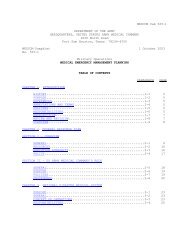(MCD) Guidelines
(MCD) Guidelines
(MCD) Guidelines
You also want an ePaper? Increase the reach of your titles
YUMPU automatically turns print PDFs into web optimized ePapers that Google loves.
<strong>Guidelines</strong> for Military Mass Casualty Decontamination Operations<br />
During a Domestic HAZMAT/Weapon of Mass Destruction Incident<br />
the nuclear detonation, height of burst and other factors, these zones can measure<br />
several miles in distance. Depending on terrain and structures, there will typically not<br />
be distinct boundaries between the damage zones.<br />
• No-Go Zone. Has the most damage to infrastructure, which will most likely be<br />
completely destroyed. The radiation level is very high and it is unlikely that any<br />
casualties will survive in this zone. However, people in substructures such as<br />
subterranean parking garages or subway tunnels may survive the initial blast.<br />
• Moderate Damage Zone. Has significant building damage and rubble, downed<br />
utility poles, overturned vehicles, and fires. Radiation levels in this zone are<br />
expected to be elevated and may be very high in some areas, but this is the zone<br />
has the greatest lifesaving potential. Casualties will come from this zone and will<br />
have thermal, blast, and radiation injuries. Most of the injured will require help<br />
and/or extraction to receive decontamination and treatment.<br />
• Light Damage Zone. Buildings typically will have broken windows with light<br />
damage to other infrastructure. A majority of the casualties will be ambulatory and<br />
can self-evacuate for decontamination and treatment. Radiation levels in this zone<br />
maybe slightly elevated from normal background levels.<br />
• Dangerous Fallout Zone. The area covered by fallout that impacts responder<br />
life-saving operations and/or has acute radiation injury potential to the population.<br />
This area is not identified by structural or other damage—it is based on fallout<br />
radiation levels. Typically this zone will consist of radiation levels of 10 Roentgen<br />
per hour or higher. Depending on various parameters (wind, atmosphere, and/or<br />
geographic terrain), this zone could extend 20 plus miles from the point of<br />
detonation and can include parts of the no-go, moderate damage and light<br />
damage zones. Existence of radiation beyond this zone may still require some<br />
sort of protective action.<br />
Regarding a nuclear detonation, the most effective life-saving opportunities for<br />
response officials in the fist 60 minutes will be the decision to safely shelter or<br />
evacuate people in expected fallout areas. 56<br />
8.1.2. Identify and Rule Out<br />
Contaminants<br />
INTENT: Determine the contaminant to the best<br />
extent possible. Determine appropriate levels of<br />
PPE based upon the type of hazard identified.<br />
Knowing what agent that contaminated the<br />
casualties allows the Incident Commander to<br />
establish 1) the level of IPE/PPE to be worn by<br />
responders during response operations, 2) to<br />
determine <strong>MCD</strong> decontamination processes to<br />
be used, and 3) modify the <strong>MCD</strong> processes as<br />
appropriate as the incident response progresses.<br />
For example, in the case of oily agents like VX or<br />
<strong>MCD</strong> Principles for<br />
Identifying Contaminants<br />
DHS UTL Tasks<br />
• ResB1b 7.4.3, 7.5.1, and 7.5.2<br />
• ResB2b 5.5, 5.5.1.1, 5.5.1.3, 5.5.2,<br />
5.5.3, and 5.5.4<br />
USACBRNS Tasks<br />
• 03-1-6592 Step 7<br />
• 03-2-6591 Steps 2a, 3c, 3f, 6, 8d<br />
• 03-2-6594 Step 3c<br />
• 03-3-0038<br />
• 03-3-5127 Steps 1f, 4d, and 15<br />
• 03-3-5128 Steps 4d and 6<br />
• 03-3-5130 Step 7f<br />
34 Original



